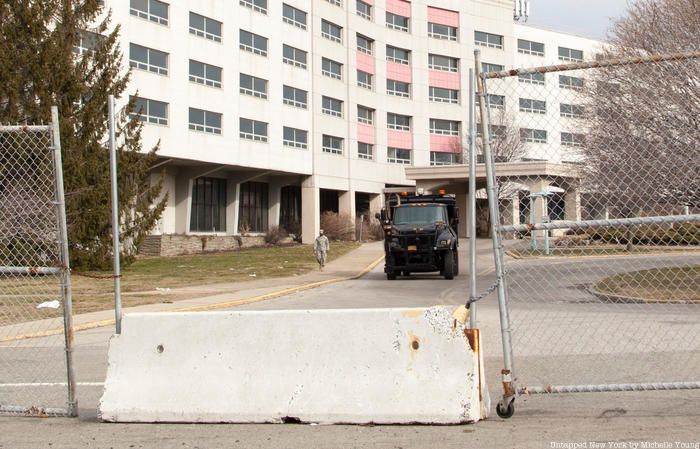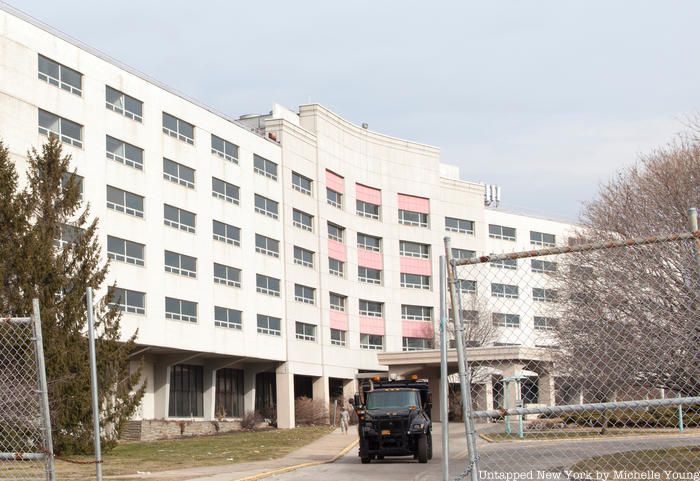Last Chance to Catch NYC's Holiday Notalgia Train
We met the voices of the NYC subway on our nostalgia ride this weekend!


John F. Kennedy Airport got a shiny new hotel last year, the TWA Hotel, a dazzling repurposing of the mid-century TWA Flight Center. But forgotten on the other side of the airport is the abandoned Ramada Plaza, until 2009, the only hotel at JFK Airport. The Ramada is most renown for its role as the “Heartbreak Hotel,” the nickname it received because it housed so many relatives of victims of plane crashes in the 1990s and 2000s.
The hotel was in Airport Building 144, located within a tear-dropped shaped property near the interchange of the Van Wyck Expressway and Route 878 as you enter the airport. The AirTrain from Jamaica runs right by it. The hotel had three wings and 478 rooms across six floors, including the lobby level. Guests would exit off the Van Wyck onto 150th Avenue and enter the hotel into a roundabout that culminated in an entrance canopy.
In its first iteration, the hotel was a Travelodge and was later taken over by Westmont Hospitality Group and Ramada Franchise Canada. When the AirTrain was being planned, various routes were considered either behind or between an existing FAA building and the Ramada Plaza. In the end, the AirTrain ran in front of the hotel, making it a visible landmark as you ride the AirTrain from Jamaica station.

Military personnel and equipment at the former Ramada Plaza
The Ramada Plaza served as a “makeshift grief counseling center,” wrote the New York Daily News in 1996 following the TWA Flight 800 crash. The sad story recounts the period of time when bereaved families could not yet reclaim the bodies of those they lost, and medical examiners were interviewing them to note details that might help identification. The hotel also served in the same capacity following the SwissAir Flight 111 crash in 1998 (off of Nova Scotia), EgyptAir Flight 990 in 1999, and the American Airlines Flight 587 crash in November 2001.

CNN reported how the hotel specifically trained for tragic events, with the CEO of Ramada Hotels Steven Belmonte saying, “We have become very, very good, very sensitive about handling these situations.” A specific red phone would ring to alert the hotel a plane crash had happened.
The front desk clerk, Gail Galloway, said in the interview, “When that red phone rings, my heart goes like this. It’s a horrible feeling when that phone goes off.” Once the red phone rang, up to 200 additional staff were brought in right away and Belmonte said that within an hour and a half, the hotel would be “fully up and operational within an hour and a half.” This included activation of a chapel in the hotel, child care, work space for the Red Cross, airline officials and government authorities.
The rooms were prepared by housekeeping with extra care for the victim’s families, including teddy bears, candy, and tissues. Even the chef, following the American Airlines crash, prepared traditional Dominican food since many of the victims were from the Dominican Republic. In the 2001 crash, a hotel staff member lost three friends, but continued to work.
Citing a need for cost savings and renovation at the site, the Port Authority closed the Ramada in 2009, with plans to open a new hotel elsewhere at the airport. That plan would become the TWA Hotel, which has yet to see an aviation disaster. In 2014, it was reported that labor issues had stalled plans to redevelop the Ramada Plaza and there has been little to no news since. For now, the former Ramada Plaza sits in its abandoned state beneath the AirTrain. On our visit, military personnel were manning the building, with fencing and concrete barriers blocking the entrances.
Next, discover the Top 10 Secrets of John F. Kennedy Airport.
Subscribe to our newsletter